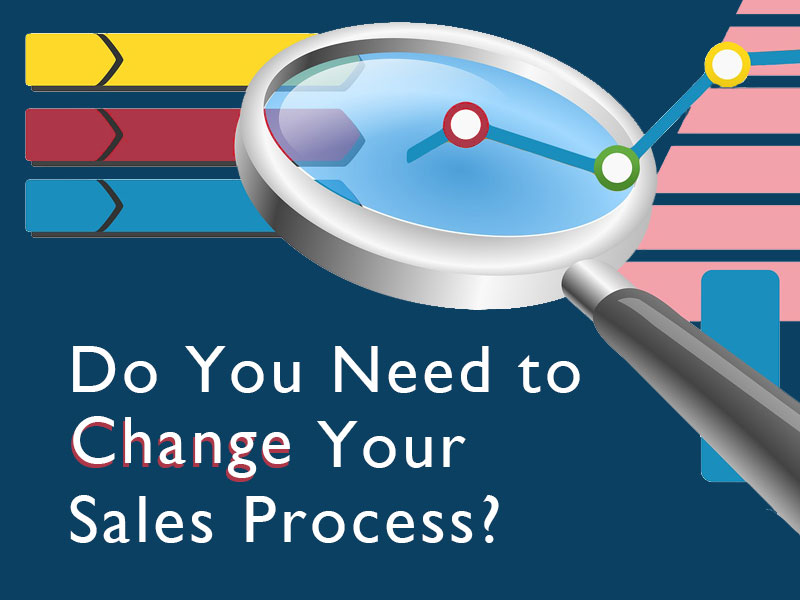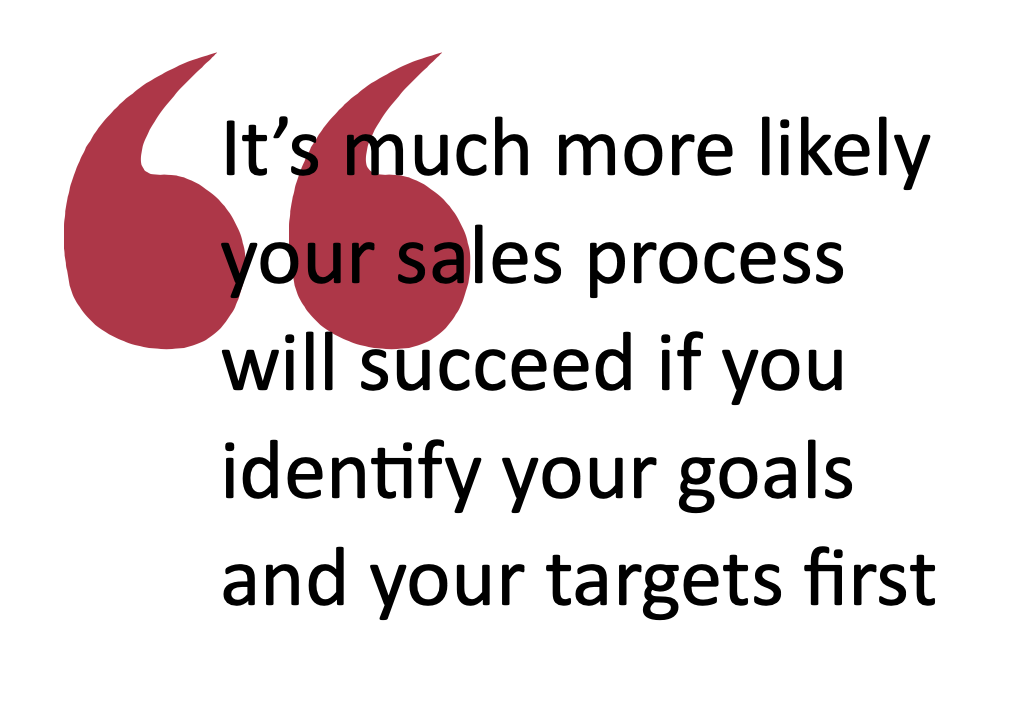
Your company has a sales process, whether you realize it or not. In other words, a way to sell your goods or services that brings ROI. So the three most important questions in today’s difficult sales climate are these:
- How does your company’s process achieve the sales you need in order to sustain your business?
- Do the phases of your sales process logically lead the buyer step by step through their buyer’s journey?
- Is your process then delivering the increased results you were expecting?
Maybe you have a blueprint that you suggest every salesperson follows. Or perhaps you just leave them to decide what’s the best approach according to their own disposition and talent. Both sound credible on the surface but they’re flawed in essence.
That’s because they’re both hit-and-miss processes that don’t result in a coordinated approach.
Our combined experiences at 360 Consulting tell us it’s much more likely your sales process will succeed if you identify your goals and your targets first, and then implement a sales infrastructure and process that unerringly moves towards those targets. You might decide to write this clearly in a systemized business manual, reference book, or playbook.
So, let’s deep-dive into the subject so you can decide if you need to tweak or change your sales process before 2022 sweeps in with its inevitable further challenges.
What Does a Sales Process Include?
We’re referring to a set of repeatable steps that a sales rep takes to close a sale successfully. Typically most sales processes involve the following steps in each complete sales cycle:
- Prospecting – Understand the marketplace, know your products, find potential ideal, or minimally suitable, customers.
- Approaching – Get your customer’s attention, maybe face to face or perhaps virtually.
- Qualifying – Research and collect all relevant information about your prospects and tailor your initial communications to your potential client’s particular needs as best you can.
- Discovery – This is where we actually start the sales cycle. Be prepared with the best possible discovery questions to determine how best you are, or are not, a fit for the prospect. This is the most critical step to success in selling.
- Presenting – Actively demonstrate how your product/service works and will uniquely benefit the customer.
- Handling objections – Address and manage your potential target’s objections depending on their feedback. Objections are awesome! These are buying signals, so be prepared to address them effectively.
- Closing – Invite a decision from the client.
- Following up – Keep in contact to nurture them for repeat business or referrals.
Why Should You Have a Planned Sales Process?
As we implied, having a carefully planned, understood, and universally implemented sales process will guarantee more business. It’s the infrastructure that supports everything else. In addition, the benefits for your business include:
Increasing the Confidence of Your Sales Reps
With clear, defined steps to guide them on what to do at each stage, sales reps are able to close deals more confidently and avoid winging it every time there’s an objection or misunderstanding.
Faster Onboarding of Your New Staff
When you recruit new staff, it’s easier to train them by showing them what they need to do in each sales cycle. When the entire sales team is following the same sales process, sales managers and other team members can pass on their own knowledge and guidance more easily.
Allowing Room for Growth/Improvement in Your Sales Process
A carefully thought-out sales process gives you the chance to test out strategies and methods on real customers to see how well they work. You can then improve and refine those methods on the fly as well as focus efforts on activities that generate most revenue for you. Without a sales process in place, this gets messy.
Improving Communication Within Your Company
A unified sales process improves collaboration and communication between your departments. And that streamlined communication in turn leads to more efficient performance between Sales, Marketing, and Operations. Organizing and strategizing in sync instead of in silos will ensure you reach targets and business goals.
Receiving More Useful Insight into Sales Performance
You can better track sales KPIs when a sales team has a proper structure. The reason is that a sales process provides more granular data at each stage. This makes it easier for sales managers to analyze key metrics and overall performance. They therefore gain more useful insights on the reasons for, and impact of, the specific actions your sales teams are taking.
Engendering Better Overall Customer Experience
A carefully planned sales process gives you the possibility of bringing about a customer-first approach. Sales reps used to be pushy. Gradually, they became more customer focused. But increasingly today, what’s needed is a two-way dialogue with the customer.
Having a sales process that encompasses this two-way attitude will ensure your potential customers are not bombarded but rather “worked with” until they’re ready to make a purchase based on authenticity and relationship.
Helping You Avoid Common Sales Mistakes
Without a written and agreed sales process, it’s easy to make mistakes such as:
- Not being able to identify sales opportunities in the market and not identifying your target customer accurately enough.
- Attempting to close sales too soon by pushing the process faster than the customer is willing to go.
- Waiting too long to both address the customer’s inquiries and close the sale (the opposite of the above).
- Not understanding – and therefore not heeding – the prospect’s personal values and decision processes.
- And worst of all, having a sales pipeline of “stuck” deals.
When Might You Need to Implement a New Sales Process?
1 When You’re Not Winning New Customers and Business
The bottom line is results, but if you’re not seeing the results you need or believe are possible, it’s time to take action. Dig in and truly understand how best to align your products and services with your prospective or existing customers. Be intentional and measure the impact of working through your sales process.
2 When You’re Entering a New Market or Introducing a New Product
A sales process that worked in your current market may not necessarily work when you enter a new market. So you need new methods and strategies. The same applies when launching a new product. You should start over and curate a sales process that will work in any new circumstance.
3 If You Have a Long Sales Cycle
A long sales cycle means you may need to reduce certain steps in your sales process. Too many sales presentations or too many calls trying to close a sale can be an annoyance rather than the intended nudge.
This is especially so with high-end products and B2B customers who now find it difficult to choose between multiple sellers and come to buying decisions. They may only spend 5-6% of their time with any single rep, who must tread wisely!
4 When You Get Significant Feedback From Prospects
Feedback is a great way to adjust your strategies and processes with a real target audience. It gives you insights on what should be done to set you apart from other sellers in the market.
So, encourage your sales reps to collect feedback, and use it to refine your sales process to fit what you represent and what your customer wants.
We Can Help You!
If you think it’s time to implement a new sales process and are wondering where to start, don’t be discouraged! At 360 Consulting, we’re expert in all things sales, and will help you revise your sales process as if our own livelihoods depended on it. Schedule a free consultation with us today. You have nothing to lose.

